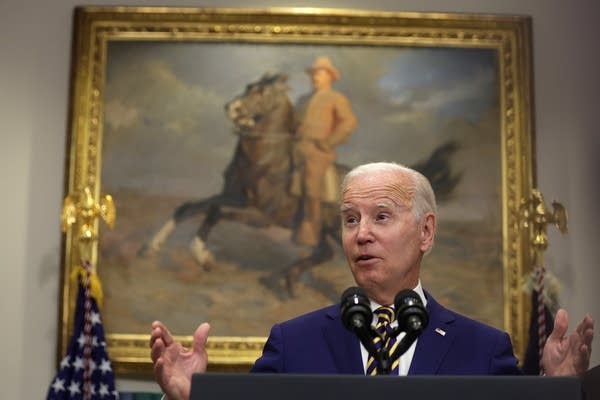Peter Cox
August 26, 2022

President Joe Biden speaks on student loan debt in the Roosevelt Room of the White House Wednesday in Washington, DC. Biden announced steps to forgive $10,000 in student loan debt for borrowers who make less than $125,000 per year and cap payments at 5 percent of monthly income.
Alex Wong | Getty Images
For most current and former students, the Biden administration's proposals this week on student debt were good news. But now borrowers are in a scramble to find which proposals they qualify for.
Biden's announcement generated a huge amount of interest. Shortly after, the federal student aid website crashed and has since required a waiting room for people visiting the site because of the volume.
Student Henri Wingo said that her loans from four years at Minneapolis College already cause her anxiety as she gets ready to look for a job. She is carrying $5,500 in student debt, a number she expects to grow. Wingo plans to graduate with a graphic design degree in the spring.
Before Wednesday’s announcement, she worried she would have to jump at the first job offer just to pay off the loans.
"It it allows me so much freedom from this massive burden on my back that I've been carrying for the last four years," Wingo said.
Students from two-year technical or community colleges bear the biggest financial burden from loans, according the U.S. Department of Education. While their debts may be smaller than those who went to four year schools, the group sees loan defaults at the highest rate.
"This gives them some breathing room, that's going to allow them to, quite honestly buy groceries, allow them to maybe start thinking about moving from an apartment to a house, that's gonna allow them to have transportation freedom of buying a car," said Michael Dean, executive director, Lead MN, a group that represents community and technical college students across the state.
To qualify for relief, individuals have to earn less than $125,000 a year or less than $250,000 for households.
Loans must have been originated before July 1 of this year. The administration is proposing reducing minimum payments for people on income-based repayment plans and proposing forgiving those loans after ten years of regular payments rather than 20.
"We have close to 782,000 Minnesotans that hold an open federal loan right now. That total cumulative debt represents about $26.7 billion," said Dennis Olson, Minnesota's higher education commissioner.
But that relief is relative.
Daphne Berlin-Fish has more than $100,000 in loans for her degrees in archive management and public history — degrees she'd hoped to use to work in museums. But that hasn't panned out yet. She's working at a labor union and trying to pay down her debt.
Berlin-Fish was hoping for the $50,000 in debt relief some Democrats had been advocating for when Biden first announced his plan.
"This is a drop in the bucket for me. Personally, this knocks me down from basically $105,000 to $95,000. And then once interest kicks back in at the end of the year, that $105,000 is going to come back in no time,” she said.
Minnesota would have to change its tax code to prevent people from having to pay taxes on the loans that are forgiven, which could be up to $20,000.
The administration is expected to roll out more details and information on how to apply for loan forgiveness in the coming weeks.
MPR News Reporter Brian Bakst contributed to this story.
No comments:
Post a Comment